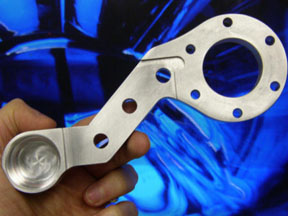|
Aluminum Alloys . . . Virtually All Aluminum is an Alloy!Aluminum Alloys . . . Why is aluminum corrosion a benefit? Is aluminum the most abundant element on earth? Is aluminum important to the human body? Why is it in such demand? What is Aluminium? No, I didn't spell it wrong!

Aluminum Alloys . . . and Wet Jet Precision, Inc. your information station. Now that sounded corny! Still, it's good information! Aluminum is such a fascinating element! It is the 3rd most abundant element on earth. Oxygen takes number one, and silicone number two. Because of its affinity to oxygen, it is almost never found in the elemental state. Despite its natural abundance, aluminum has no known function in living cells, but rather presents some toxic effects in elevated concentrations. It is not, however, as toxic as heavy metals. People in the United States typically spell "Aluminum" without an i before the last -um. That sounded kind of funny, but look at it through the eyes of the rest of the world. "Aluminium", is how they spell it. While discussing aluminum alloys, I'll spell it aluminum without the extra "i". It's hard enough for some to pronounce "aluminun" as it is. Aluminum was first produced in 1825. It is a lightweight structural material that can be strengthened through alloying and, depending upon composition, further strengthened by heat treatment and/or cold working (mechanically shaping it). Aluminum is 100% recyclable. It is very cost effective to recycle because it requires only 5% of the energy used to produce it originally from bauxite ore. There is about a 15% dross loss. You would think that I tried to make that rhyme, but I didn't. Pure aluminum has a low tensile strength, until it is tempered. What is temper? It is the quality of metal that describes its ability to spring back after it is flexed. It is it's stiffness. Soft temper means that when it is bent, it stays bent, and it doesn't take much force to bend it. Hard temper means that when it is bent, it will spring back, and it will take a lot of force to put a bend in it. Temper has no relevance to hardness, color, machinability, or weldability. After it is tempered, it has a very high strength to weight ratio. It is about one-third as dense and stiff as steel. It can be welded, brazed, riveted, or bonded with adhesive (glued). It can easily be machined, rolled, cast, stamped, drawn, spun, roll-formed, hammered, forged, or extruded, and can have a wide variety of surface finishes. The anodizing process was invented for use with aluminum alloys, and therefore is often used to improve color and strength. Corrosion resistance can be excellent. When it is exposed to the atmosphere, a thin layer of aluminum oxide forms. This oxide skin effectively prevents further oxidation. This oxide layer is not generally visible, but if the metal is touched, a black smudge comes off on your hand. A general exception to corrosion resistance, is when aluminum is penetrated by alkaline substances such as salt spray from winter streets, or exposure to seawater, especially in the presence of a dissimilar metal (galvanic reaction). Aluminum is a very good thermal conductor, and electrical conductor, and is highly reflective to heat and light. At extremely high temperatures, aluminum loses some of its strength. It will actually melt without changing appearance, however at subzero temperatures, it increases in strength while retaining its relative malleable qualities. It is not a very good high temperature alloy, but is an excellent low temperature alloy. Knowing the properties of aluminum alloys will always give you an advantage when procuring the material for your next project! For ongoing tips and information on Water Jet Cutting and related processes, Subscribe to our Newsletter, "A Cut Above the Rest!" Click Here! to Subscribe, top left.
Abrasive Waterjet Cutting, Contact Us!
Water Jet Cutting Home
|







